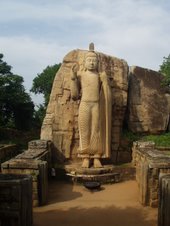Call it a coincidence, but the first time I visited Sri Lanka two years ago was the exact time the Boxing Day tsunami happened. Since then, there has been a great deal of redevelopment going on, although there are various places which are still under reconstruction and areas that look excatly the same. Northern and eastern areas controlled by the LTTE are - so I've heard - still in pretty bad shape.
A few days ago we visited Bentota - a small tourist resort about one hoursouth of Colombo. The area was decimated by the tsunami, but when we visited no one who knew any better would have guessed that a few years earlier the place was a mess of dead vegetation, flotsam and jetsom and the remains of victims of the tsunami. Those in the know observed that many of the resorts were completely missing, and that the river adjacent to the ocean had become a lagoon.
Bentota beach - mugshot of a murderer:
Bentota beach:

This beach is the area that Kumudu's family visits annually - it is a marvelous place. The sands are so fine its like flour, there are no shells and the water is beautiful and warm - it really is the archetype of paradise. In 2004, we planned to visit their holiday home which is located not even one hundred yards from the beach. A few days before this however, the home was completely destroyed. When we visited two days ago, there was a huge pool of water where the home should have been.
My own memories of 2004 Boxing Day are simple: we woke up to news that there had been a terrorist attack. Then that there had been some small accident. Still later we heard that there had been a flood. None of these reports compared to what had really happened. Knowing something serious had happened we called our respective families not to worry if they heard anything bad. Even Colombo wasn't unaffected - the canals just 150 yards from our home were flooded, and the Dehiwala train station had been washed out. Moratuwa, a stretch of coastal slum-like buildings where fisherman were based, was completely destroyed. We were all shocked by the devastation.
Moratuwa 2004 - What was left of peoples homes:

Moratuwa, 2004 - "Close" , Understatement of the year:

We kept well away from the coasts, not wishing to get in the way of the sudden influx of aid that had arrived, not to mention our desire to avoid infection: the coastal areas were rife with disease. When we visited Yala a few weeks after Boxing day, the air was sick with disease and we couldn't even leave the vehicle we were driving in. Regretably, I saw people bathing in clearly infected water: In other words, it was completely yellow and putrid.
Yala 2004, the water as it was then:

Yala 2004, people were bathing in this water. The day before the water on the far side was clogged with bodies:

Since then, laws were put in place preventing people building along the coast. If this is true, it certainly has not been implemented since the areas pictured above are now just the same they were before the tsunami: a mish-mash of slums and impromptu housing. But one thing that has always amazed me is the resilience of the Sri Lankan people. Directly after the tsunami people were straight back at work, and Colombo was as busy as ever. Meanwhile, the people devastated by the tsunami were doing their best to recover and were as optimistic as always. Other subsequent developments involve political complications over aid distribution. The Sri Lankan government were reticient to direct aid funds to the LTTE controlled areas on account that it was feared (with good reason I suspect) that the money would be misused, i.e. to fund the war. When I visited the warehouse at Pelligoda a few weeks ago, there was - reputably - still undelivered aid that had not even been cleared by customs since 2004. It was still sitting there in the boxes it had been packaged in. The aid in that warehouse - food, medicine and equipment - was rusting and expired.


No comments:
Post a Comment